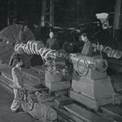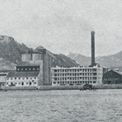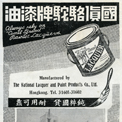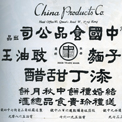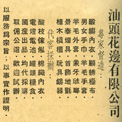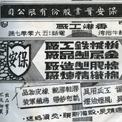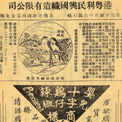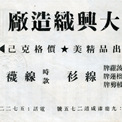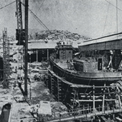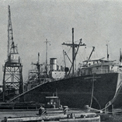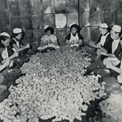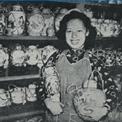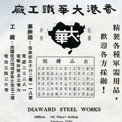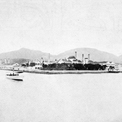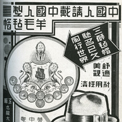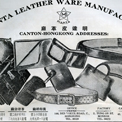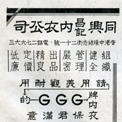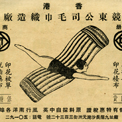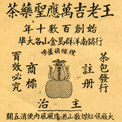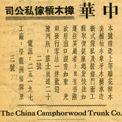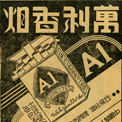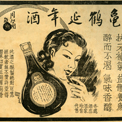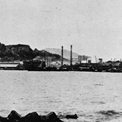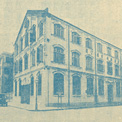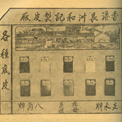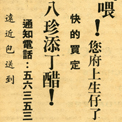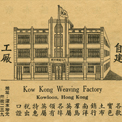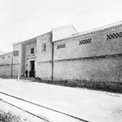Green Island Cement Company, Ltd.
The Green Island Cement Company was established in 1890 by the Messrs. Shewan, Tomes & Co. It was initially built on the Green Island near Macao and in 1899 a larger and more fully equipped factory was opened in Hong Kong, in Hok Yuen, an area on the Kowloon side of the harbour. Raw materials for the manufacture of cement in Hong Kong consisted of hard limestone, clay, iron ore, gypsum and coal. The two essential components - clay and iron ore - were available from the soil of Hong Kong, whereas limestone was brought from the neighbourhood of Canton. Green Island cement was comparable to the best English and European manufacture, the more famous products in the 1950s were Portland cement as well as Low Heat and Sulphate Resisting Cement. The company was also agents in Hong Kong for the largest cement manufacturers in the world. It also imported and distributed a number of other imported products to the local construction sites.

| Date | 1908 |
| Industry | cement |
| others | manufacturing |
| Material Type | Image |
| Collection | Pre-war Industry |
| Source | Wright, Arnold (ed.) 1908. Twentieth Century Impressions of Hong Kong, p.237. Singapore: Graham Brash. |
| Repository | The University of Hong Kong Libraries |
| Note to Copyright | Copyright expires |
| Accession No. | WL-HIS-014e |
Green Island Cement Company, Ltd.
The Green Island Cement Company was established in 1890 by the Messrs. Shewan, Tomes & Co. It was initially built on the Green Island near Macao and in 1899 a larger and more fully equipped factory was opened in Hong Kong, in Hok Yuen, an area on the Kowloon side of the harbour. Raw materials for the manufacture of cement in Hong Kong consisted of hard limestone, clay, iron ore, gypsum and coal. The two essential components - clay and iron ore - were available from the soil of Hong Kong, whereas limestone was brought from the neighbourhood of Canton. Green Island cement was comparable to the best English and European manufacture, the more famous products in the 1950s were Portland cement as well as Low Heat and Sulphate Resisting Cement. The company was also agents in Hong Kong for the largest cement manufacturers in the world. It also imported and distributed a number of other imported products to the local construction sites.
| Date | 1908 |
| Industry | cement |
| Others | manufacturing |
| Material Type | Image |
| Collection | Pre-war Industry |
| Source | Wright, Arnold (ed.) 1908. Twentieth Century Impressions of Hong Kong, p.237. Singapore: Graham Brash. |
| Repository | The University of Hong Kong Libraries |
| Note to Copyright | Copyright expires |
| Accession No. | WL-HIS-014e |
Green Island Cement Company, Ltd.
The Green Island Cement Company was established in 1890 by the Messrs. Shewan, Tomes & Co. It was initially built on the Green Island near Macao and in 1899 a larger and more fully equipped factory was opened in Hong Kong, in Hok Yuen, an area on the Kowloon side of the harbour. Raw materials for the manufacture of cement in Hong Kong consisted of hard limestone, clay, iron ore, gypsum and coal. The two essential components - clay and iron ore - were available from the soil of Hong Kong, whereas limestone was brought from the neighbourhood of Canton. Green Island cement was comparable to the best English and European manufacture, the more famous products in the 1950s were Portland cement as well as Low Heat and Sulphate Resisting Cement. The company was also agents in Hong Kong for the largest cement manufacturers in the world. It also imported and distributed a number of other imported products to the local construction sites.
| Date | 1908 |
| Industry | cement |
| Others | manufacturing |
| Material Type | Image |
| Collection | Pre-war Industry |
| Source | Wright, Arnold (ed.) 1908. Twentieth Century Impressions of Hong Kong, p.237. Singapore: Graham Brash. |
| Repository | The University of Hong Kong Libraries |
| Note to Copyright | Copyright expires |
| Accession No. | WL-HIS-014e |
Green Island Cement Company, Ltd.
The Green Island Cement Company was established in 1890 by the Messrs. Shewan, Tomes & Co. It was initially built on the Green Island near Macao and in 1899 a larger and more fully equipped factory was opened in Hong Kong, in Hok Yuen, an area on the Kowloon side of the harbour. Raw materials for the manufacture of cement in Hong Kong consisted of hard limestone, clay, iron ore, gypsum and coal. The two essential components - clay and iron ore - were available from the soil of Hong Kong, whereas limestone was brought from the neighbourhood of Canton. Green Island cement was comparable to the best English and European manufacture, the more famous products in the 1950s were Portland cement as well as Low Heat and Sulphate Resisting Cement. The company was also agents in Hong Kong for the largest cement manufacturers in the world. It also imported and distributed a number of other imported products to the local construction sites.
| Date | 1908 |
| Industry | cement |
| Others | manufacturing |
| Material Type | Image |
| Collection | Pre-war Industry |
| Source | Wright, Arnold (ed.) 1908. Twentieth Century Impressions of Hong Kong, p.237. Singapore: Graham Brash. |
| Repository | The University of Hong Kong Libraries |
| Note to Copyright | Copyright expires |
| Accession No. | WL-HIS-014e |
Green Island Cement Company, Ltd.
The Green Island Cement Company was established in 1890 by the Messrs. Shewan, Tomes & Co. It was initially built on the Green Island near Macao and in 1899 a larger and more fully equipped factory was opened in Hong Kong, in Hok Yuen, an area on the Kowloon side of the harbour. Raw materials for the manufacture of cement in Hong Kong consisted of hard limestone, clay, iron ore, gypsum and coal. The two essential components - clay and iron ore - were available from the soil of Hong Kong, whereas limestone was brought from the neighbourhood of Canton. Green Island cement was comparable to the best English and European manufacture, the more famous products in the 1950s were Portland cement as well as Low Heat and Sulphate Resisting Cement. The company was also agents in Hong Kong for the largest cement manufacturers in the world. It also imported and distributed a number of other imported products to the local construction sites.
| Date | 1908 |
| Sponsors | manufacturing |
| Industry | cement |
| Material Type | Image |
| Collection | Pre-war Industry |
| Source | Wright, Arnold (ed.) 1908. Twentieth Century Impressions of Hong Kong, p.237. Singapore: Graham Brash. |
| Repository | The University of Hong Kong Libraries |
| Note to Copyright | Copyright expires |
| Accession No. | WL-HIS-014e |
Green Island Cement Company, Ltd.
The Green Island Cement Company was established in 1890 by the Messrs. Shewan, Tomes & Co. It was initially built on the Green Island near Macao and in 1899 a larger and more fully equipped factory was opened in Hong Kong, in Hok Yuen, an area on the Kowloon side of the harbour. Raw materials for the manufacture of cement in Hong Kong consisted of hard limestone, clay, iron ore, gypsum and coal. The two essential components - clay and iron ore - were available from the soil of Hong Kong, whereas limestone was brought from the neighbourhood of Canton. Green Island cement was comparable to the best English and European manufacture, the more famous products in the 1950s were Portland cement as well as Low Heat and Sulphate Resisting Cement. The company was also agents in Hong Kong for the largest cement manufacturers in the world. It also imported and distributed a number of other imported products to the local construction sites.
| Date | 1908 |
| Others | manufacturing |
| Industry | cement |
| Material Type | Image |
| Collection | Pre-war Industry |
| Source | Wright, Arnold (ed.) 1908. Twentieth Century Impressions of Hong Kong, p.237. Singapore: Graham Brash. |
| Repository | The University of Hong Kong Libraries |
| Note to Copyright | Copyright expires |
| Accession No. | WL-HIS-014e |
Green Island Cement Company, Ltd.
The Green Island Cement Company was established in 1890 by the Messrs. Shewan, Tomes & Co. It was initially built on the Green Island near Macao and in 1899 a larger and more fully equipped factory was opened in Hong Kong, in Hok Yuen, an area on the Kowloon side of the harbour. Raw materials for the manufacture of cement in Hong Kong consisted of hard limestone, clay, iron ore, gypsum and coal. The two essential components - clay and iron ore - were available from the soil of Hong Kong, whereas limestone was brought from the neighbourhood of Canton. Green Island cement was comparable to the best English and European manufacture, the more famous products in the 1950s were Portland cement as well as Low Heat and Sulphate Resisting Cement. The company was also agents in Hong Kong for the largest cement manufacturers in the world. It also imported and distributed a number of other imported products to the local construction sites.
| Date | 1908 |
| Industry | cement |
| Others | manufacturing |
| Material Type | Image |
| Collection | Pre-war Industry |
| Source | Wright, Arnold (ed.) 1908. Twentieth Century Impressions of Hong Kong, p.237. Singapore: Graham Brash. |
| Repository | The University of Hong Kong Libraries |
| Note to Copyright | Copyright expires |
| Accession No. | WL-HIS-014e |
Green Island Cement Company, Ltd.
The Green Island Cement Company was established in 1890 by the Messrs. Shewan, Tomes & Co. It was initially built on the Green Island near Macao and in 1899 a larger and more fully equipped factory was opened in Hong Kong, in Hok Yuen, an area on the Kowloon side of the harbour. Raw materials for the manufacture of cement in Hong Kong consisted of hard limestone, clay, iron ore, gypsum and coal. The two essential components - clay and iron ore - were available from the soil of Hong Kong, whereas limestone was brought from the neighbourhood of Canton. Green Island cement was comparable to the best English and European manufacture, the more famous products in the 1950s were Portland cement as well as Low Heat and Sulphate Resisting Cement. The company was also agents in Hong Kong for the largest cement manufacturers in the world. It also imported and distributed a number of other imported products to the local construction sites.
| Date of Death | 1908 |
| Industry | cement |
| Others | manufacturing |
| Material Type | Image |
| Collection | Pre-war Industry |
| Source | Wright, Arnold (ed.) 1908. Twentieth Century Impressions of Hong Kong, p.237. Singapore: Graham Brash. |
| Repository | The University of Hong Kong Libraries |
| Note to Copyright | Copyright expires |
| Accession No. | WL-HIS-014e |
Green Island Cement Company, Ltd.
The Green Island Cement Company was established in 1890 by the Messrs. Shewan, Tomes & Co. It was initially built on the Green Island near Macao and in 1899 a larger and more fully equipped factory was opened in Hong Kong, in Hok Yuen, an area on the Kowloon side of the harbour. Raw materials for the manufacture of cement in Hong Kong consisted of hard limestone, clay, iron ore, gypsum and coal. The two essential components - clay and iron ore - were available from the soil of Hong Kong, whereas limestone was brought from the neighbourhood of Canton. Green Island cement was comparable to the best English and European manufacture, the more famous products in the 1950s were Portland cement as well as Low Heat and Sulphate Resisting Cement. The company was also agents in Hong Kong for the largest cement manufacturers in the world. It also imported and distributed a number of other imported products to the local construction sites.
| Date | 1908 |
| Material Type | Image |
| Collection | Pre-war Industry |
| Source | Wright, Arnold (ed.) 1908. Twentieth Century Impressions of Hong Kong, p.237. Singapore: Graham Brash. |
| Note to Copyright | Copyright expires |
| Accession No. | WL-HIS-014e |
Green Island Cement Company, Ltd.
The Green Island Cement Company was established in 1890 by the Messrs. Shewan, Tomes & Co. It was initially built on the Green Island near Macao and in 1899 a larger and more fully equipped factory was opened in Hong Kong, in Hok Yuen, an area on the Kowloon side of the harbour. Raw materials for the manufacture of cement in Hong Kong consisted of hard limestone, clay, iron ore, gypsum and coal. The two essential components - clay and iron ore - were available from the soil of Hong Kong, whereas limestone was brought from the neighbourhood of Canton. Green Island cement was comparable to the best English and European manufacture, the more famous products in the 1950s were Portland cement as well as Low Heat and Sulphate Resisting Cement. The company was also agents in Hong Kong for the largest cement manufacturers in the world. It also imported and distributed a number of other imported products to the local construction sites.
| Date | 1908 |
| Material Type | Image |
| Others | manufacturing |
| Industry | cement |
| Collection | Pre-war Industry |
| Source | Wright, Arnold (ed.) 1908. Twentieth Century Impressions of Hong Kong, p.237. Singapore: Graham Brash. |
| Repository | The University of Hong Kong Libraries |
| Note to Copyright | Copyright expires |
| Accession No. | WL-HIS-014e |
Green Island Cement Company, Ltd.
The Green Island Cement Company was established in 1890 by the Messrs. Shewan, Tomes & Co. It was initially built on the Green Island near Macao and in 1899 a larger and more fully equipped factory was opened in Hong Kong, in Hok Yuen, an area on the Kowloon side of the harbour. Raw materials for the manufacture of cement in Hong Kong consisted of hard limestone, clay, iron ore, gypsum and coal. The two essential components - clay and iron ore - were available from the soil of Hong Kong, whereas limestone was brought from the neighbourhood of Canton. Green Island cement was comparable to the best English and European manufacture, the more famous products in the 1950s were Portland cement as well as Low Heat and Sulphate Resisting Cement. The company was also agents in Hong Kong for the largest cement manufacturers in the world. It also imported and distributed a number of other imported products to the local construction sites.
| Date | 1908 |
| Industry | cement |
| Others | manufacturing |
| Material Type | Image |
| Collection | Pre-war Industry |
| Source | Wright, Arnold (ed.) 1908. Twentieth Century Impressions of Hong Kong, p.237. Singapore: Graham Brash. |
| Repository | The University of Hong Kong Libraries |
| Note to Copyright | Copyright expires |
| Accession No. | WL-HIS-014e |
Green Island Cement Company, Ltd.
The Green Island Cement Company was established in 1890 by the Messrs. Shewan, Tomes & Co. It was initially built on the Green Island near Macao and in 1899 a larger and more fully equipped factory was opened in Hong Kong, in Hok Yuen, an area on the Kowloon side of the harbour. Raw materials for the manufacture of cement in Hong Kong consisted of hard limestone, clay, iron ore, gypsum and coal. The two essential components - clay and iron ore - were available from the soil of Hong Kong, whereas limestone was brought from the neighbourhood of Canton. Green Island cement was comparable to the best English and European manufacture, the more famous products in the 1950s were Portland cement as well as Low Heat and Sulphate Resisting Cement. The company was also agents in Hong Kong for the largest cement manufacturers in the world. It also imported and distributed a number of other imported products to the local construction sites.
| Date | 1908 |
| Others | manufacturing |
| Material Type | Image |
| Industry | cement |
| Collection | Pre-war Industry |
| Source | Wright, Arnold (ed.) 1908. Twentieth Century Impressions of Hong Kong, p.237. Singapore: Graham Brash. |
| Repository | The University of Hong Kong Libraries |
| Note to Copyright | Copyright expires |
| Accession No. | WL-HIS-014e |
Green Island Cement Company, Ltd.
The Green Island Cement Company was established in 1890 by the Messrs. Shewan, Tomes & Co. It was initially built on the Green Island near Macao and in 1899 a larger and more fully equipped factory was opened in Hong Kong, in Hok Yuen, an area on the Kowloon side of the harbour. Raw materials for the manufacture of cement in Hong Kong consisted of hard limestone, clay, iron ore, gypsum and coal. The two essential components - clay and iron ore - were available from the soil of Hong Kong, whereas limestone was brought from the neighbourhood of Canton. Green Island cement was comparable to the best English and European manufacture, the more famous products in the 1950s were Portland cement as well as Low Heat and Sulphate Resisting Cement. The company was also agents in Hong Kong for the largest cement manufacturers in the world. It also imported and distributed a number of other imported products to the local construction sites.
| Date | 1908 |
| Others | manufacturing |
| Material Type | Image |
| Industry | cement |
| Collection | Pre-war Industry |
| Source | Wright, Arnold (ed.) 1908. Twentieth Century Impressions of Hong Kong, p.237. Singapore: Graham Brash. |
| Repository | The University of Hong Kong Libraries |
| Note to Copyright | Copyright expires |
| Accession No. | WL-HIS-014e |
Green Island Cement Company, Ltd.
The Green Island Cement Company was established in 1890 by the Messrs. Shewan, Tomes & Co. It was initially built on the Green Island near Macao and in 1899 a larger and more fully equipped factory was opened in Hong Kong, in Hok Yuen, an area on the Kowloon side of the harbour. Raw materials for the manufacture of cement in Hong Kong consisted of hard limestone, clay, iron ore, gypsum and coal. The two essential components - clay and iron ore - were available from the soil of Hong Kong, whereas limestone was brought from the neighbourhood of Canton. Green Island cement was comparable to the best English and European manufacture, the more famous products in the 1950s were Portland cement as well as Low Heat and Sulphate Resisting Cement. The company was also agents in Hong Kong for the largest cement manufacturers in the world. It also imported and distributed a number of other imported products to the local construction sites.
| Date | 1908 |
| Others | manufacturing |
| Material Type | Image |
| Industry | cement |
| Collection | Pre-war Industry |
| Source | Wright, Arnold (ed.) 1908. Twentieth Century Impressions of Hong Kong, p.237. Singapore: Graham Brash. |
| Repository | The University of Hong Kong Libraries |
| Note to Copyright | Copyright expires |
| Accession No. | WL-HIS-014e |
Green Island Cement Company, Ltd.
The Green Island Cement Company was established in 1890 by the Messrs. Shewan, Tomes & Co. It was initially built on the Green Island near Macao and in 1899 a larger and more fully equipped factory was opened in Hong Kong, in Hok Yuen, an area on the Kowloon side of the harbour. Raw materials for the manufacture of cement in Hong Kong consisted of hard limestone, clay, iron ore, gypsum and coal. The two essential components - clay and iron ore - were available from the soil of Hong Kong, whereas limestone was brought from the neighbourhood of Canton. Green Island cement was comparable to the best English and European manufacture, the more famous products in the 1950s were Portland cement as well as Low Heat and Sulphate Resisting Cement. The company was also agents in Hong Kong for the largest cement manufacturers in the world. It also imported and distributed a number of other imported products to the local construction sites.
| Date | 1908 |
| Others | manufacturing |
| Material Type | Image |
| Industry | cement |
| Collection | Pre-war Industry |
| Source | Wright, Arnold (ed.) 1908. Twentieth Century Impressions of Hong Kong, p.237. Singapore: Graham Brash. |
| Repository | The University of Hong Kong Libraries |
| Note to Copyright | Copyright expires |
| Accession No. | WL-HIS-014e |
Green Island Cement Company, Ltd.
The Green Island Cement Company was established in 1890 by the Messrs. Shewan, Tomes & Co. It was initially built on the Green Island near Macao and in 1899 a larger and more fully equipped factory was opened in Hong Kong, in Hok Yuen, an area on the Kowloon side of the harbour. Raw materials for the manufacture of cement in Hong Kong consisted of hard limestone, clay, iron ore, gypsum and coal. The two essential components - clay and iron ore - were available from the soil of Hong Kong, whereas limestone was brought from the neighbourhood of Canton. Green Island cement was comparable to the best English and European manufacture, the more famous products in the 1950s were Portland cement as well as Low Heat and Sulphate Resisting Cement. The company was also agents in Hong Kong for the largest cement manufacturers in the world. It also imported and distributed a number of other imported products to the local construction sites.
| Date | 1908 |
| Others | manufacturing |
| Material Type | Image |
| Industry | cement |
| Collection | Pre-war Industry |
| Source | Wright, Arnold (ed.) 1908. Twentieth Century Impressions of Hong Kong, p.237. Singapore: Graham Brash. |
| Repository | The University of Hong Kong Libraries |
| Note to Copyright | Copyright expires |
| Accession No. | WL-HIS-014e |
Green Island Cement Company, Ltd.
The Green Island Cement Company was established in 1890 by the Messrs. Shewan, Tomes & Co. It was initially built on the Green Island near Macao and in 1899 a larger and more fully equipped factory was opened in Hong Kong, in Hok Yuen, an area on the Kowloon side of the harbour. Raw materials for the manufacture of cement in Hong Kong consisted of hard limestone, clay, iron ore, gypsum and coal. The two essential components - clay and iron ore - were available from the soil of Hong Kong, whereas limestone was brought from the neighbourhood of Canton. Green Island cement was comparable to the best English and European manufacture, the more famous products in the 1950s were Portland cement as well as Low Heat and Sulphate Resisting Cement. The company was also agents in Hong Kong for the largest cement manufacturers in the world. It also imported and distributed a number of other imported products to the local construction sites.
| Date | 1908 |
| Others | manufacturing |
| Material Type | Image |
| Industry | cement |
| Collection | Pre-war Industry |
| Source | Wright, Arnold (ed.) 1908. Twentieth Century Impressions of Hong Kong, p.237. Singapore: Graham Brash. |
| Repository | The University of Hong Kong Libraries |
| Note to Copyright | Copyright expires |
| Accession No. | WL-HIS-014e |
Green Island Cement Company, Ltd.
The Green Island Cement Company was established in 1890 by the Messrs. Shewan, Tomes & Co. It was initially built on the Green Island near Macao and in 1899 a larger and more fully equipped factory was opened in Hong Kong, in Hok Yuen, an area on the Kowloon side of the harbour. Raw materials for the manufacture of cement in Hong Kong consisted of hard limestone, clay, iron ore, gypsum and coal. The two essential components - clay and iron ore - were available from the soil of Hong Kong, whereas limestone was brought from the neighbourhood of Canton. Green Island cement was comparable to the best English and European manufacture, the more famous products in the 1950s were Portland cement as well as Low Heat and Sulphate Resisting Cement. The company was also agents in Hong Kong for the largest cement manufacturers in the world. It also imported and distributed a number of other imported products to the local construction sites.
| Date | 1908 |
| Others | manufacturing |
| Material Type | Image |
| Industry | cement |
| Collection | Pre-war Industry |
| Source | Wright, Arnold (ed.) 1908. Twentieth Century Impressions of Hong Kong, p.237. Singapore: Graham Brash. |
| Repository | The University of Hong Kong Libraries |
| Note to Copyright | Copyright expires |
| Accession No. | WL-HIS-014e |
Copyright © 2012 Hong Kong Memory


